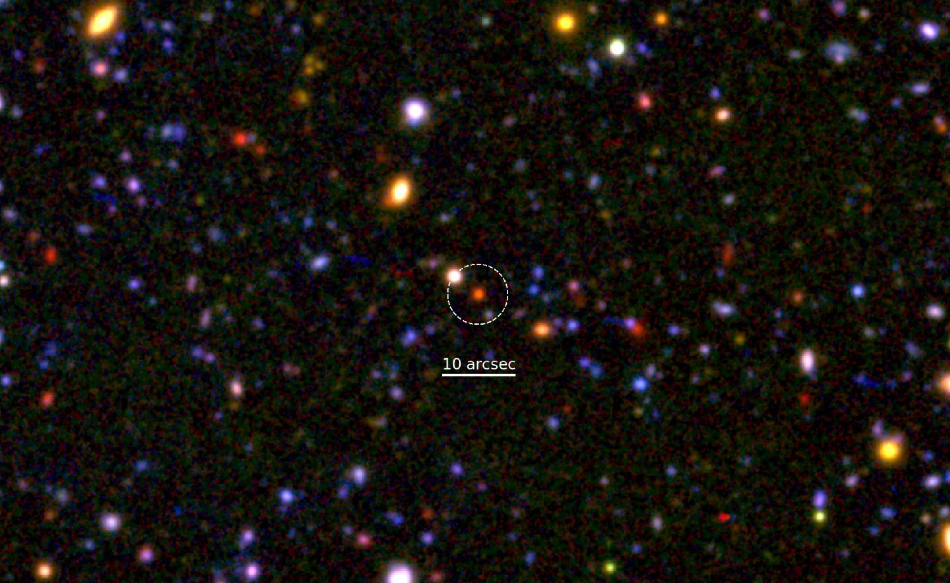Jan 20 2020
The furthest dying galaxy discovered so far includes more than a trillion stars and is a lot larger than the Milky Way. Observation of this galaxy has shown that these systems have “cores” that were formed 1.5 billion years after the Big Bang, which is one billion years earlier than what previous measurements have revealed.
 A blow-up of a small portion of the Subaru/XMM-Newton Deep Field. The red galaxy at the center is a dying galaxy at 12 billion years ago. Astronomers measured the motion of stars in the galaxy and found that the core of the galaxy is nearly fully formed. Image Credit: NAOJ/M. Tanaka.
A blow-up of a small portion of the Subaru/XMM-Newton Deep Field. The red galaxy at the center is a dying galaxy at 12 billion years ago. Astronomers measured the motion of stars in the galaxy and found that the core of the galaxy is nearly fully formed. Image Credit: NAOJ/M. Tanaka.
The findings will offer more insights into the formation of the Universe in general. It might also cause the computer models used by astronomers, which are one of the most fundamental tools, to be revised.
The study outcomes, which were achieved in close collaboration with Masayuki Tanaka and his team from the National Observatory of Japan, have now been reported in two papers in the Astrophysical Journal Letters and the Astrophysical Journal.
What is a “Dead” Galaxy?
Galaxies can be widely classified as alive or dead: alive galaxies are bright with star formation activity, while dead galaxies no longer form stars. A “quenching” galaxy is a galaxy that is slowly dying—that is, its star formation is considerably inhibited.
Although the brightness of quenching galaxies is not equal to that of fully alive galaxies, these galaxies are not so dark like dead galaxies. This spectrum of brightness is used by researchers as the first line of identification during the observation of galaxies in the Universe.
The Farthest Dying Galaxy Discovered so Far Reveals Remarkable Maturity
Recently, a research team from the Cosmic Dawn Center at the Niels Bohr Institute and the National Observatory of Japan found out an enormous galaxy dying already 1.5 billion years following the Big Bang, the farthest of its type.
“Moreover, we found that its core seems already fully formed at that time,” stated Masayuki Tanaka, the author of the letter.
This result pairs up with the fact that, when these dying gigantic systems were still alive and forming stars, they might have not been that extreme compared with the average population of galaxies.
Francesco Valentino, Assistant Professor, Cosmic Dawn Center, Niels Bohr Institute
Valentino is the author of an article about the past history of dead galaxies that was published in the Astrophysical Journal.
Why Do Galaxies Die? One of the Biggest and Still Unanswered Questions in Astrophysics
“The suppressed star formation tells us that a galaxy is dying, sadly, but that is exactly the kind of galaxy we want to study in detail to understand why it dies,” added Valentino. How a star-forming galaxy changes into a dead galaxy is one of the important questions that has still not been answered by astrophysics.
For example, while the Milky Way is still alive and forming new stars gradually, in close proximity (in astronomical terms), M87—the Virgo cluster’s central galaxy—is dead and totally different. Why is it so?
It might have to do with the presence of gigantic and active black hole at the center of galaxies like M87.
Francesco Valentino, Assistant Professor, Cosmic Dawn Center, Niels Bohr Institute
Earth-Based Telescopes Find Extremes—But Astronomers Look for Normality
One main challenge in viewing galaxies in such detail is that the existing telescopes on Earth can usually find only the most extreme systems. But the solution to characterize the history of the Universe lies in the enormous and more numerous population of normal objects. “Since we are trying hard to discover this normality, the current observational limitations are an obstacle that has to be overcome.”
The James Webb Telescope (JWST) Represents Hope for Better Data Material in the Near Future
Scheduled to be introduced in 2021, the new James Webb Space Telescope will be in a position to offer the astronomers with data in such a detail that should allow mapping of precisely this “normality.”
The techniques devised by the team at the Niels Bohr Institute in close partnership with the Japanese team have already been found to be successful, due to the latest results. “This is significant, because it will enable us to look for the most promising galaxies from the start, when JWST gives us access to much higher quality data,” explained Valentino.
Combining Observations with the Tool—The Computer Models of the Universe
What has been discovered by observation is not very distant from what is predicted by the latest models.
According to Valentino, “Until very recently, we did not have many observations to compare with the models. However, the situation is in rapid evolution, and with JWST we will have valuable larger samples of ‘normal’ galaxies in a few years. The more galaxies we can study, the better we are able to understand the properties or situations leading to a certain state—if the galaxy is alive, quenching or dead.”
It is basically a question of writing the history of the Universe correctly, and in greater and greater detail. At the same time, we are tuning the computer models to take our observations into account, which will be a huge improvement, not just for our branch of work, but for astronomy in general.
Francesco Valentino, Assistant Professor, Cosmic Dawn Center, Niels Bohr Institute
The Danish National Research Foundation supports the Cosmic Dawn Center. Francesco Valentino’s study is funded by a grant from the Carlsberg Foundation: “Galaxies: Rise And Death.”